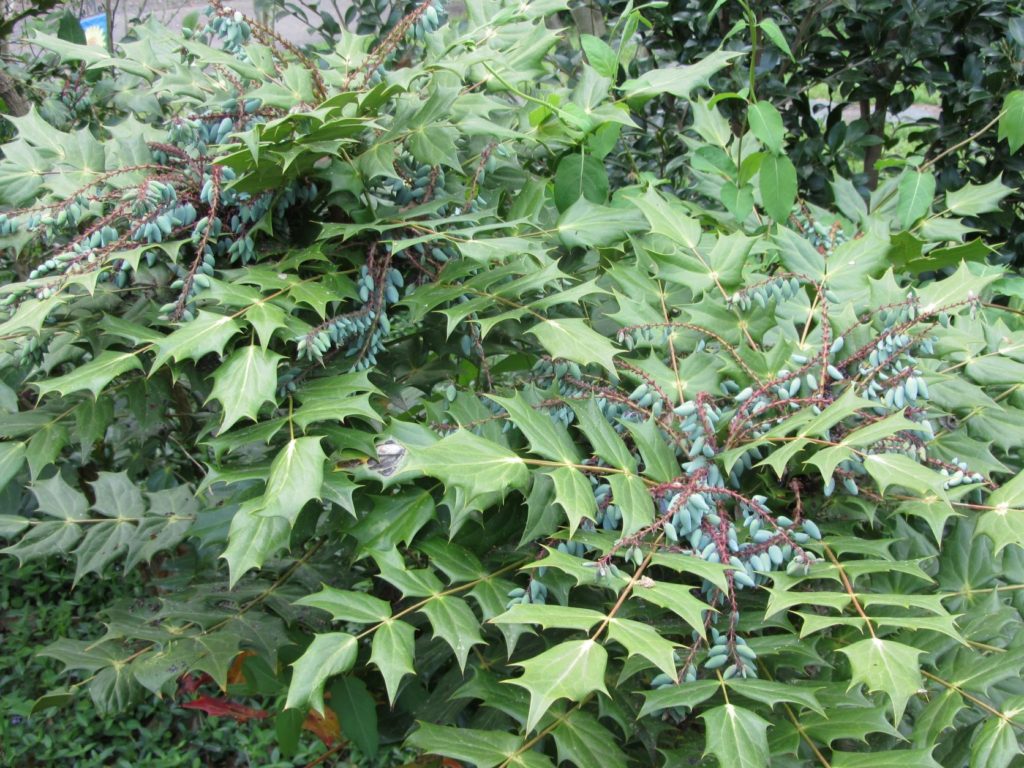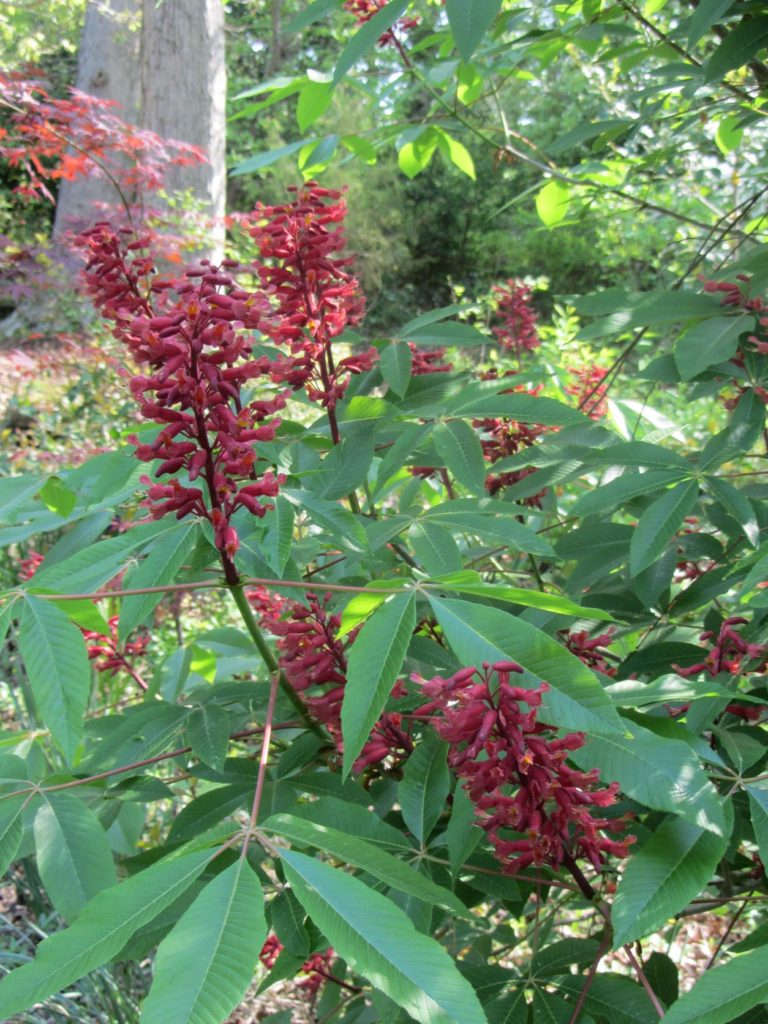Bringing Birds to the Garden
Do you feed the birds? Most of us gardeners do. Unless you are protecting a crop of blueberries or blackberries, you probably enjoy the energy and joy birds bring to the garden with their antics and songs.
Birds also vacuum up thousands of flying, crawling, and burrowing insects. Even hummingbirds eat an enormous number of insects as they fly around from blossom to blossom seeking sweet nectar. Birds are an important part of a balanced garden community.
We have everything from owls and red-tailed hawks to hummingbirds visiting our garden, and we enjoy the occasional brood of chicks raised in shrubs near the house. There are tufted titmice who pull apart the coco liners in our hanging baskets to build their nests. And, there is an extended family of cardinals who keep a vigilant watch on our comings and goings and all of the activities of the garden.
A wildlife garden welcomes many types of birds. During the frozen months especially, a lawn full of robins proves endlessly entertaining. The bright yellow flash of goldfinches brightens the dullest winter day. Some birds make our garden their year-round home; others come and go with the seasons.
There was a time when I kept feeders stocked with seed during much of the year. I felt a sense of obligation, almost, to provide for the backyard flock. What a mess!
As much as I love watching the endless parade of birds and food tray drama, there was always the pile of empty sunflower husks and spilled millet seed, and the rodents it attracts. Our first winter or two in this home, I put out pounds and pounds of food in the deep winter. Many times we watched as huge flocks of grackles swooped down and emptied our feeders in less than half a day.
Well, grackles weren’t what we had hoped to attract. We were looking for the cute and colorful birds who eat a little at a time and chirp their appreciation on the shrubs by the windows.
That brought some rather brutal soul searching about the true nature of our generosity. Did it really matter whether one type of bird or another ate the seeds I freely offered? Did it matter how many came at once, or whether the life-giving seeds were consumed by birds or squirrels? Or perhaps a raccoon at night?
It did matter. It mattered to me, and to those who share the garden, the birds, and the bill for the bird feeder with me. So, I tried a different approach; I targeted my offerings to those birds I most wanted to attract. We bought skinny stockings full of Niger seed. Niger seed attracts goldfinches, purple finches, tufted titmice, and cardinals.
After the first frost or two, when the garden was largely empty of other food, we hung the Niger seed feeders in a shrubby hazel near the living room window where we would see them easily.
This worked beautifully until the very hungry, and incredibly determined squirrels learned to tear holes in the feeder bags and gobble up the seed like it was Chicklet’s gum. After a year or so of making repairs and frequent re-filling, I finally realized the birds were living in the garden whether my little offering of purchased seed was there, or not.
Maybe we don’t need to keep buying better feeders, bigger baffles, more seed, and all sorts of other gizmos to invite birds into our garden. Bringing birds to the garden, and keeping them as residents, simply requires providing for their needs.
Meeting the Needs of Avian Visitors
Birds chiefly need shelter, safe perches, varied food sources, and a source of fresh water to choose a garden as their home. They also like their privacy. A feeder rig or birdbath placed out in a lawn, without shrubbery and trees nearby, actually makes birds vulnerable to all sorts of predators and competitors while they eat, drink and bathe.
In fact, biologists tell us that birds need insects in their diets much more than they need seeds and the other treats we like to offer at feeders. Very few bird species can feed seed to their young. Birds require a steady diet of insects to thrive and raise their chicks. And caterpillars, the larvae of butterflies and moths, are an especially important part of their diet.
We can begin by considering which birds we most want to attract, learn their preferences, and then provide those things in the garden. The trick then, to attracting birds to the garden, is simply to cultivate plants that not only meet the needs of the gardener but also meet the needs of the gardener’s favorite avian companions.
For example, large predatory birds, like hawks and owls, like to perch in the branches of large trees, well off the ground. They prefer to eat small mammals, amphibians, and reptiles. By leaving areas of old forest with tall trees intact, and wild areas where the small animals they hunt can live, we have families of these beautiful birds living around us. We hear the hawks calling to one another by day, and the owls by night.
Cardinals, robins, and grosbeaks come for the many fruits and berries provided by our shrubs; and goldfinches appear in late summer to feed on ripening seeds of basil, purple coneflowers, and Rudbeckia. Hummingbirds visit our flowers from early spring through early autumn.
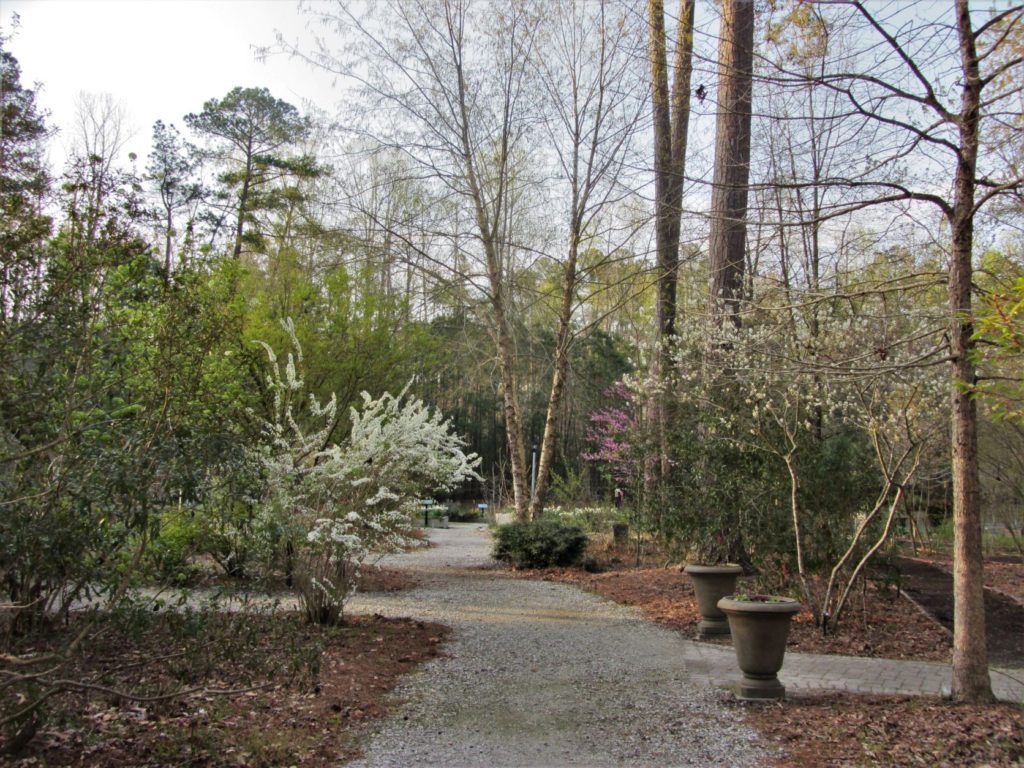
Trees and shrubs of many different heights provide shelter and perches for many different species of birds.
Creating Layers to Attract Birds
A wildlife garden is built in layers. There are the tall pines and hardwoods, the shorter understory trees, various shrubs, annual and perennial herbaceous plants, grasses, and finally ground covers. Each of these layers has something to offer to wildlife, whether food, shelter, nesting areas, perches, or playgrounds.
To bring colorful finches up close, leave some flowers to go to seed, and they will swoop in for the feast. Expect dogwood trees to fill with a variety of birds in the autumn when their drupes ripen, and the Pyracantha will lure cardinals and grosbeaks a few weeks later when its drupes are ready for harvest.
Begin with whatever trees or shrubs already grow in your yard, and plant additional useful varieties, keeping an eye on those native species well-adapted to our climate. Plant mixed borders, or hedgerows, where species of different heights, textures, colors, and forms blend together.
Just as most people are happiest among friends and family, most trees and shrubs enjoy growing in a community with others. This is how they grow in natural areas. In fact, trees planted in groves prove safer near our homes since their roots grow together, intertwined, making it more difficult for a group of trees to blow over than for a single tree to fall in a windstorm. Trees of various species and different heights attract more species of insects and more species of birds, offering a variety of choices for food and shelter throughout the year.
Avian visitors actually help spread seeds of the fruits, drupes, and berries they love from one garden to another. Over time, seedlings pop up in odd spots. Some seeds may be deposited in bird droppings while larger seeds, like acorns or beechnuts, may be buried by blue jays and squirrels. Once these volunteers sprout, you can encourage the ones you want, and remove the rest. The more different plant species your garden offers, the more interest it will hold for you, and the birds you welcome to your garden.
Here is a list of trees, and a few shrubs, native or naturalized in Eastern Virginia (Zone 7B), which attract multiple species of birds. Although the woodies listed below are either native or naturalized, in Eastern Virginia; most grow throughout much of North America. They are specifically chosen for this list because they attract birds to the garden.
They all provide food in one form or another, in addition to the myriad insects crawling and buzzing around them. But trees and shrubs offer so much more than just food. They provide shade, privacy, perches, and nesting spots. They allow birds to move about the garden safely in short swoops from one to the next.
Beautyberry Callicarpa americana Deciduous ornamental shrub to around 8′ which blooms through the summer months, with small berries quickly following each blossom. The berries turn an unusual shade of violet as they ripen. Native to the Southeastern United States, it forms clumps and thickets and easily spreads from dropped seeds.
Beautyberry attracts nectar-loving insects all summer. Birds enjoy this shrub for its ready food supply and dense growth, which gives them cover. Berries persist for many weeds, even after the leaves fall after frost. This shrub responds well to hard pruning in late winter.
American Beech, Fagus grandifolia Deciduous tree to 80’, good fall color, leaves may persist all winter. American beech trees provide excellent nesting sites for a variety of birds, including cavity dwellers. They are long-lived large trees that support pollinators in the spring, host over 125 Lepidoptera species, as well as many other insects, and produce edible nuts in the fall. Nuts are valued by a variety of wildlife, including grouse, wild turkeys, ducks, woodpeckers, white-breasted nuthatches, American crows, and blue jays. Squirrels and other animals eat buds and tender twigs in spring.
 A squirrel forages among the branches of an American Beech in April.
A squirrel forages among the branches of an American Beech in April.
Birch Betula species Deciduous, multi-stemmed tree with beautiful bark, grows to 80’, depending on the variety.
Birch attracts many different birds who nest, eat its seeds and buds, or eat insects in its foliage or bark, including dark-eyed juncos, blue jays, pine siskins, titmice, chickadees, cedar waxwings, goldfinches, purple finches, towhees, bobwhites, wood ducks, orioles, vireos, warblers, grouse.
Blueberry, Cranberry, Huckleberry Vaccinium, and Gaylussacia species Multi-stemmed deciduous shrubs to 12’, most smaller, are valued for abundant, edible fruits. These native species provide early spring flowers for pollinators and support over 280 Lepidoptera species.
Blueberries, cranberries, and huckleberries provide fruits ripening over many months to support many species of birds and other wildlife. These understory shrubs provide an important layer of dense shelter and cover for birds.
Cherry/Plum Prunus species Deciduous ornamental trees or shrubs grow from 10’-80’ depending on species and culture. All are valued for flowers in spring followed by fruits valuable to humans and wildlife. This is one of the best genera for supporting Lepidoptera species, with the native black cherry, Prunus serotina, hosting over 450 species, which then attract many species of birds.
There are many different cherry and plum trees, many of them native, and all light up the spring landscape when covered in pastel flowers. There is a Prunus suited to almost any size yard. Many, many insects visit to nectar followed by a variety of insect larvae supported by their leaves. Fall fruits attract 84 species of birds, including grosbeaks, cedar waxwing, finches, blackbirds, jays, orioles, robins, bluebirds, woodpeckers, catbirds, sparrows, mockingbirds, cardinals, thrushes, and a variety of other wildlife.
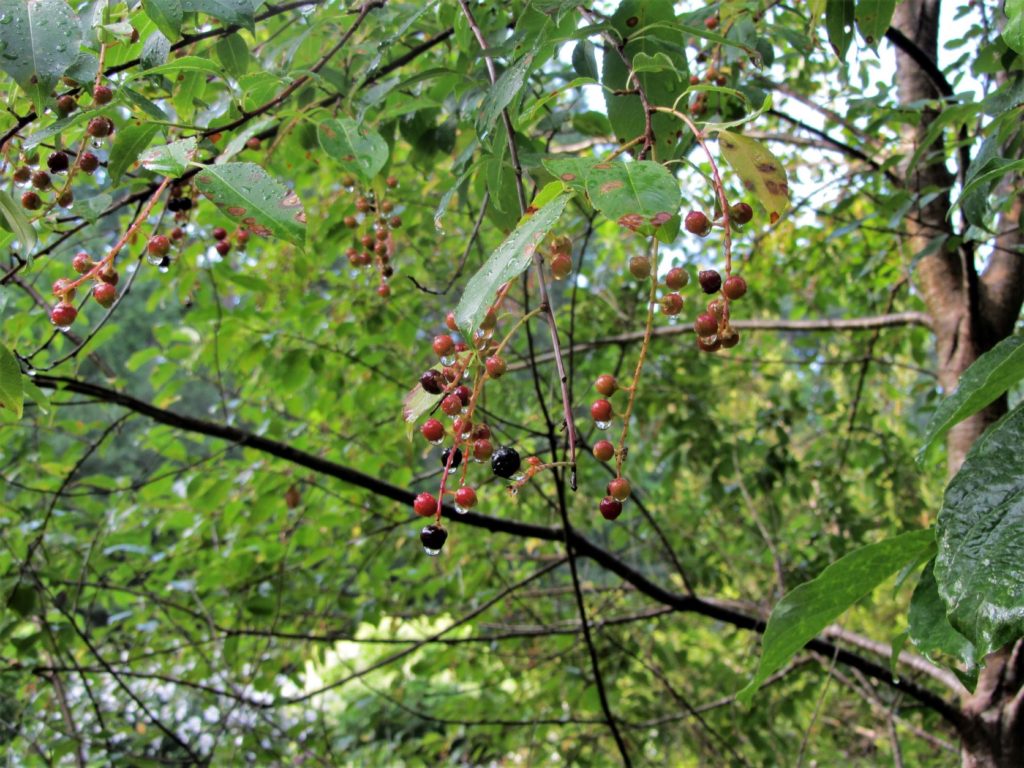
The native black cherry tree, Prunus serotina, feeds early pollinators when it blooms in the spring, and birds and small mammals when its fruit ripen in summer.
Crape Myrtle Lagerstroemia indica Deciduous ornamental tree or shrub to 30’, but most varieties smaller, cultivated for its bright flowers in shades of red, pink, lavender, and white which last approximately 100 days from July through September. Crape Myrtle was brought to North America from Asia in 1790. It has naturalized and has been widely grown ever since.
Crape Myrtle flowers attract butterflies and hummingbirds, as well as insects that hummingbirds and other birds eat. Many different birds eat the seeds which remain available all winter. Birds use Crepe Myrtles for shelter and nesting.
Eastern Cottonwood Populus deltoids Deciduous landscape tree to 100’ or more
Cottonwood attracts birds who nest, find shelter, eat its seeds, and eat the insects in its bark Including goldfinches, grosbeaks, grouse, and great blue herons. It is a larval host for over 360 Lepidoptera species.
Crab Apple Malus species Deciduous ornamental tree or shrub with spring blossoms, colorful fruit, and fall color to 30’. This is one of the best trees for supporting Lepidoptera species, serving as a host plant for more than 300 species.
Crab Apple provides secure nesting and roosting sites for many birds, nectar in spring for a variety of insects, including bees. Fall fruit attracts many species of birds. Including cedar waxwing, robin, mockingbird, finches, bobwhite, woodpecker, flicker, grosbeak.
 Native dogwood, Cornus florida, blooms in April.
Native dogwood, Cornus florida, blooms in April.
Dogwood Cornus florida Deciduous ornamental spring blooming tree with colorful fall foliage and drupes to 40’.
Dogwood attracts many different types of birds who nest, eat its fruits, or eat insects from the bark. Ninety-eight different species of birds eat Dogwood drupes including flickers, tanagers, woodpeckers, catbird, thrashers, bluebirds and cardinals.
Hawthorn Crataegus species A deciduous ornamental spreading tree with spines, which produces beautiful fruits. There are more than 200 species in North America including many natural hybrids. This member of the Rosaceae family has horny branches, making these trees especially valuable for nesting birds. Grows to 30’
Hawthorn attracts over 39 different types of birds who nest, eat its fruit, or eat insects from its foliage. Including robin, purple finch, several different grosbeaks, cedar waxwing, blue jay, mockingbird, chickadees, warblers, cardinals, and hummingbirds. It also hosts over 150 Lepidoptera species.
American Hazelnut, Filbert Coryalus americana, and Coryalus cornuta Deciduous, suckering shrubs grow into a dense thicket of small trees, offering excellent shelter and nesting sites for a variety of birds. Showy male catkins in late winter are decorative. Small nuts are edible, tasty, and attract a variety of wildlife. Grows to 12’ tall.
American Hazelnut attracts a wide variety of wildlife including songbirds, butterflies, squirrels, deer, turkeys, grouse, quail, and a wide variety of insects. It is a valuable host plant for over 130 species of moths and butterflies. Nuts may be roasted and eaten or ground into flour. Wood can be coppiced, and the slender stems have a variety of uses, including making baskets, barriers, and plant supports.
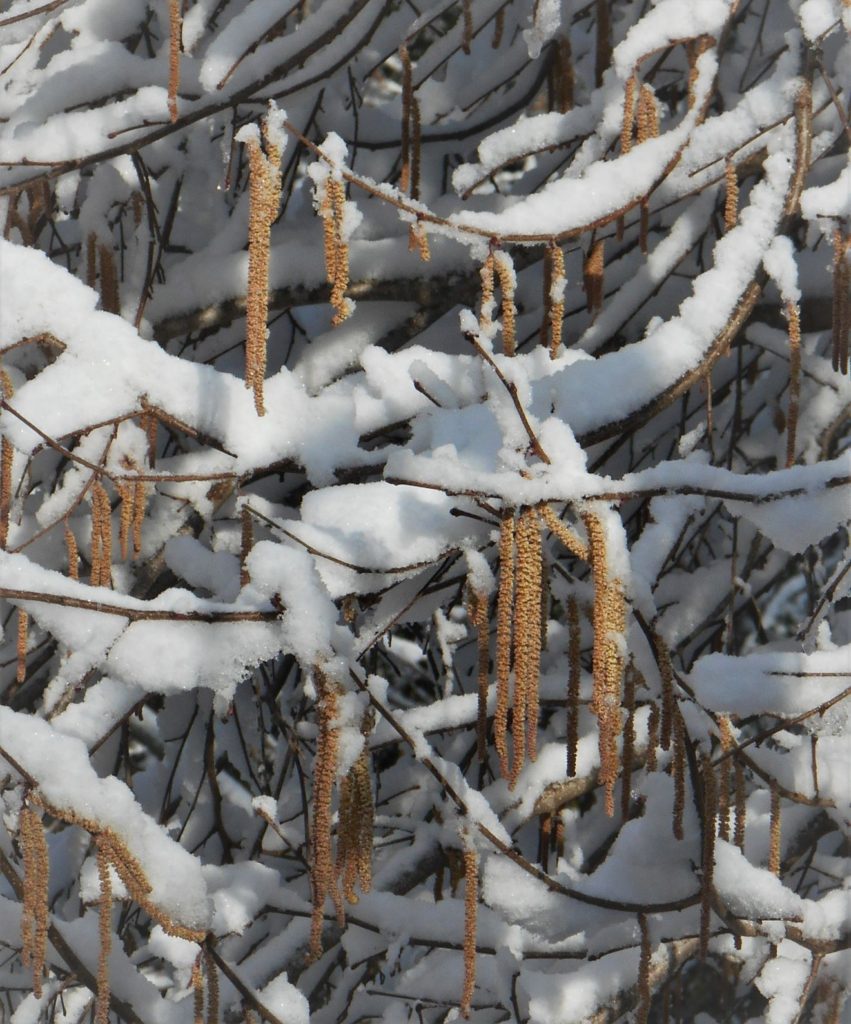
Hazel trees bloom in late winter. These male catkins grow to several inches long and disappear as the leaves unfold later in spring.
The Hercules’ Club, or Devil’s Walking Stick, Aralia spinosa Deciduous native shrub with a very thorny trunk, crowns itself with a huge spray of flowers each summer, quickly followed by inky purple berries.
This plant spreads with runners and readily self-seeds. It grows along the edges of roads where it leans into the sun. It is striking when in bloom and in berry, but grows best in low-traffic areas where the gardener won’t get caught on its thorns! Long compound leaves give this tree a tropical appearance, and butterflies come to nectar on its flowers.
Holly Ilex opaca and other species Most species are evergreen, grow to 50’, and are covered in drupes in winter. Native Ilex verticillata, known as winterberry, is deciduous.
Holly species provide shelter and protected nesting sites for many birds. Late winter flowers provide an important nectar source for early pollinators. Over 49 avian species enjoy their fruits, including cardinal, mockingbird, catbird, brown thrasher, bluebirds, cedar waxwing, and robin.
Magnolia species, Magnolia grandiflora, and Magnolia virginiana Deciduous or evergreen ornamental trees to 100′ Magnolia produces large, showy fragrant blooms in spring, and then forms seed-filled cones in summer. Several species of Lepidoptera use Sweetbay Magnolia as a host plant, including the Spicebush Swallowtail and the Eastern Tiger Swallowtail. Sapsuckers frequent Magnolias trees, as well as many other species of small birds that seek out their drupes. These large trees provide shade. Birds find secure cover under the large, thick leaves of Magnolia grandiflora.
Maple Acer species Deciduous landscape tree, grows to 70’ Maple attracts many different types of birds who nest, eat its seeds, or eat insects from the bark, including grosbeaks, finches, pine siskins, cardinals, nuthatches, bobwhites, orioles, wrens, warblers, chickadees. Maples are excellent shade trees with outstanding fall colors.
Mulberry Morus Rubra Deciduous, a native ornamental tree that produces edible berries to 60’. Morus alba and Morus nigra, both imported species, produce fruit and support Lepidoptera larvae, but can prove invasive.
Spring flowers support a wide variety of pollinators. Leaves are valuable food for caterpillars, including silkworm caterpillars. Fruits are delicious in pies and over ice cream. Mulberry attracts many different birds who nest, 59 species who eat its berries, and others who eat insects on its bark, Including bluebird, cedar waxwing, orioles, cardinal, blue jay, grosbeaks, woodpeckers, yellow-billed cuckoo, kingbird, warblers, robin, titmouse, and mockingbird.
Oak Quercus species Deciduous or evergreen landscape trees to 100’ or more, depending on species. Oak is regarded by many biologists as the most important tree for sustaining a wide variety of wildlife and various genera support over 530 different species of Lepidoptera, in addition to a wide range of other insects.
Oak is one of the most important wildlife and landscape trees. Acorns support a variety of wildlife and are edible for humans. Oaks attract birds who nest, find shelter, eat the acorns, and eat the insects in the bark and foliage including woodpeckers, chickadees, titmice, cardinals, flickers, grouse, blue jays, meadowlarks, nuthatches, doves, thrushes, ducks, bobwhites, quail, grosbeaks, and scarlet tanagers.
Oregon Grape Holly Mahonia aquifolium Ornamental evergreen shrub to 5’. Its thick, spiny leaves won’t be grazed by deer and provide important cover for birds.
Mahonia offers winter flowers for nectar-loving insects and dark purple clusters of edible drupes by late spring. Its dense cover, when established, offers shelter from the weather and protected nesting areas. Mahonia has naturalized in central and eastern Virginia. Recently, it was moved to the genus of Berberis, so it is more properly known as Berberis aquifolium.
Pine Pinus species Evergreen tree to 100’ or more which produces seeds in cones. Pine species also support over 200 species of Lepidoptera, and other insects, attractive to birds.
Pine attracts birds to nest, roost, eat its seeds, and even eat its needles. Birds also eat the many insects attracted to pine trees. Pine is one of the most important trees for wildlife. Species attracted Incl. woodpeckers, chickadees, grosbeaks, nuthatches, jays, dark eyed juncos, pine siskins, meadowlarks, woodpeckers, thrashers, warblers, grouse, robins, doves, cardinals, and finches.
Red Cedar Juniperus virginiana Evergreen tree to 50’ with aromatic leaves and blueberries. Foliage is good for holiday decorations and its aromatic wood for storing clothing.
Cedar provides shelter during bad weather, protected nesting and roosting sites for many birds, and over 54 species eat its fruit. Incl. cedar waxwing, purple finch, robin, evening grosbeak, warblers, flickers, mockingbird, bluebird, bobwhite, swallows, eastern kingbirds, jays, and cardinals.
Scarlet Buckeye, Firecracker Plant, Aesculus pavia Deciduous multi-stemmed ornamental shrub or tree to 30’ which produces clusters of red flowers in spring important as a food source for hummingbirds and bees, followed by seeds in the fall. Leaves and seeds are poisonous to humans but are attractive to wildlife.
Scarlet Buckeye attracts hummingbirds and nectar-loving insects when in bloom. Many species of birds are attracted to feed on the insects, nest, and find shelter under its large leaves. Squirrels eat the seeds.
Scarlet Firethorn, Pyracantha coccinea Evergreen multi-stemmed thorny shrub to 18’ that produces red or orange berries in fall that persist through winter. Birds relish the berries and find safe nesting sites within the dense, thorny stems of scarlet firethorn. Pollinators are attracted to its abundant flowers each spring.
This upright, dense shrub may be espaliered, grown as a specimen plant or as an impenetrable hedge. It is highly deer resistant, and its long thorns make it a good plant for a wildlife hedgerow or barrier along a property line. Native to Southern Europe, it is considered a desirable, drought tolerant ornamental plant, but it requires pruning to keep it thinned and shaped.
Sumac Rhus species Deciduous multi-stemmed shrub or tree to 30’ with brilliant fall foliage and abundant berries.
Sumac trees are an important winter food source for nearly a hundred species of birds.
American Sycamore Platanus occidentalis Deciduous landscape tree to over 100’ with excellent fall color
American Sycamore provides shelter, protected nesting, and roosting sites, and winter seeds and insects for many bird species including goldfinches and chickadees.
Tulip Tree Liriodendron tulipifera Deciduous landscape tree to well over 100’ tall. Its spring blossoms are an important source of nectar for many pollinators, including hummingbirds and cedar waxwings. This is an especially beautiful tree with interest year-round.
Tulip Poplar provides shelter, protected nesting and roosting sites for many birds, and many avian species eat both its flowers and seeds and the insects living on it. Liriodendron is a host plant for the Eastern Tiger Swallowtail and Spicebush Swallowtail, and the Viceroy butterflies. Leaves, buds, twigs, and seeds support many types of wildlife, including small mammals and deer.
Wax Myrtle, Bayberry Myrica cerifera, M. caroliniensis, and M. pensylvanica Dense evergreen shrub to 40’ with small blueberries covered in wax. Small spring flowers attract nectar-loving insects. Leaves host the Red-banded Hairstreak butterfly.
Wax Myrtle berries are eaten by 86 species of birds, including robins, tufted titmouse, finches, chickadee, bluebirds, bobwhite, swallow, woodpeckers, cardinals, and finches. Its dense structure makes it an excellent shelter and nesting site.
Willow Salix species Deciduous tree or shrub to 50’; one of the first trees to leaf out in the spring. Salix babylonica, or weeping willow, is an imported tree (from Asia) that has naturalized in our area. It provides excellent shelter and nesting sites. There are 97 species in North America, many of these are shrubs.
Willows support over 450 Lepidoptera species and so provide abundant larval food for a variety of birds. These trees thrive on wet soil, beside ponds and other waterways, where they help filter pollutants from the water and control erosion.
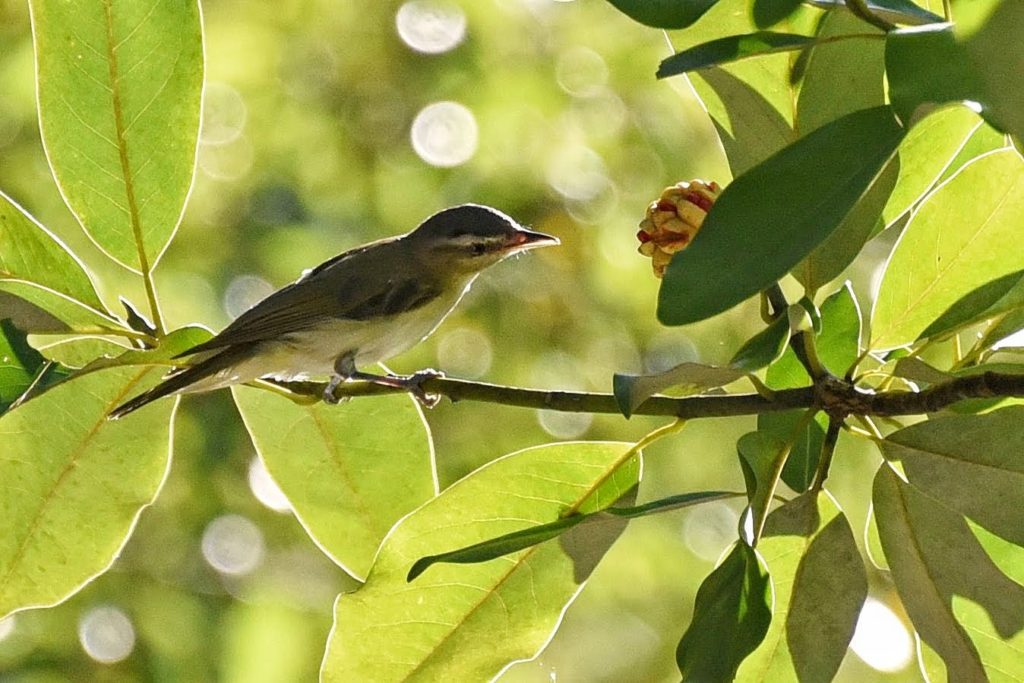
Red-eyed Vireo on Sweetbay, Magnolia virginiana, at the Williamsburg Botanical Garden. Photo by Jim Eastman
Bibliography and Sources:
Adams, George. Birdscaping Your Garden: A Practical Guide to Backyard Birds and the Plants That Attract Them. Rodale Books. 1994.
Roth, Sally. Bird-by-Bird Gardening: The Ultimate Guide to Bringing In Your Favorite Birds- Year after Year. Rodale Books. 2006.
Tallamy, Douglas. Bringing Nature Home: How You Can Sustain Wildlife with Native Plants (updated and expanded). Timber Press. 2007.
Tallamy, Douglas. The Nature of Oaks: The Rich Ecology of Our Most Essential Native Trees. Timber Press. 2021.
All Photos by E. L. McCoy or Jim Eastman








